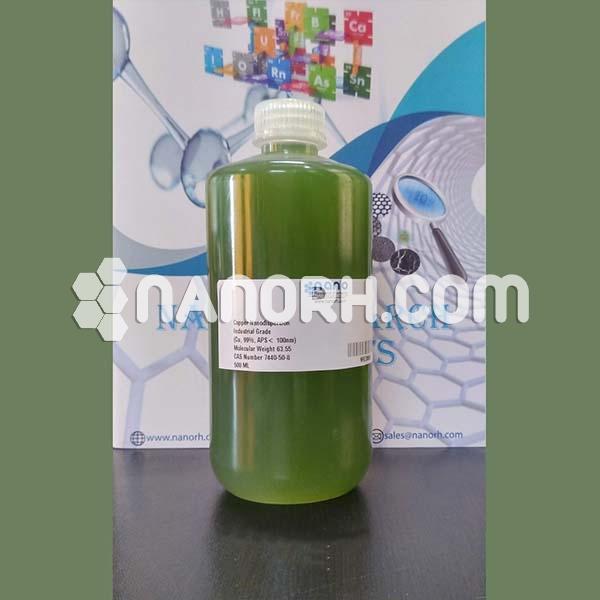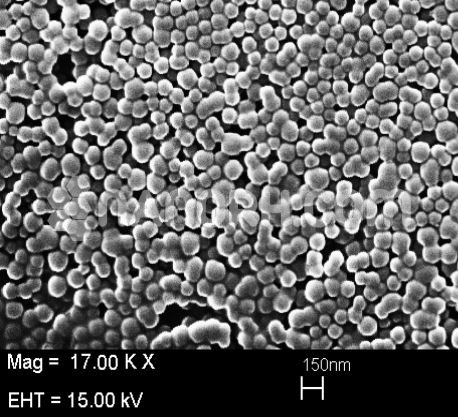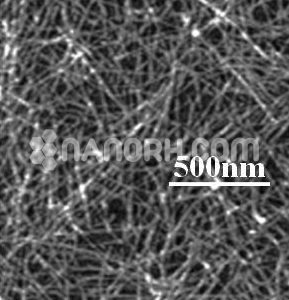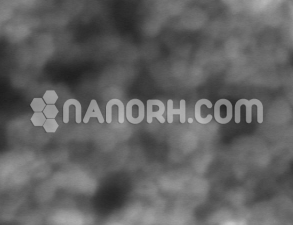Organic Copper Nano Dispersion
Copper Nano Dispersion
| Organic Copper Nano Dispersion | |
| Product No. | NRE-22001 |
| CAS No. | 7440-50-8 |
| Formula | Cu |
| Molecular Weight | 63.546 g/mol |
| Purity | 99.9% |
| Concentration | 1000ppm |
| Solvent | Water (as per requirement) |
| Form | Liquid |
| Certificate Of Analysis | |
| Cu | 99.9 % |
| Fe | 0.02 % |
| Na | 0.02 % |
| K | 0.02 % |
| Cl | 0.02 % |
| Co | 0.02 % |
Organic copper Nano Dispersion
One of the first and most natural questions asked when starting to deal with nanoparticles is “Why are nanoparticles so interesting? Why work with these extremely small structures that are challenging to handle and synthesize especially when compared with their macroscopic counterparts?” The answer lies in the unique properties possessed by these nanoparticles. Nanoparticles are of great scientific interest as they bridge the gap between bulk materials and atomic or molecular structures. A bulk material has constant physical properties regardless of its size, but at the nano-scale, this is often not the case. Several well-characterized bulk materials have been found to possess the most interesting properties when studied in the nanoscale. There are many reasons for this including the fact that nanoparticles possess a very high aspect ratio. Nanoscale systems like encapsulation and entrapment of agrochemicals such as fertilizers, pesticides, herbicides, plant growth regulators and other active substances by using polymers, dendrimers, surface ionic attachments, and other mechanisms may be used in controlled and slow release of agrochemicals, which allow the slow uptake of active ingredients and in turn, reduces the amount of agrochemical application by minimizing the input and waste. The importance of nanoscale delivery system in agriculture is because of its improved solubility and stability to degradation in the environmental factors. The nanoscale delivery vehicles increase effectiveness by binding firmly to the plant surface and reduces the number of agrochemicals by preventing runoff into the environment.
Nanomaterials also play an important role in promoting sustainable agriculture and provide better foods globally. In developing countries, nanotechnology has got an important application for enhancing agricultural productivity, along with other emerging technologies such as biotechnology including genetics, plant breeding, disease control, fertilizer technology, precision agriculture, and other allied fields. Nanotechnology can be used for combating the plant diseases either by the controlled delivery of functional molecules or as a diagnostic tool for disease detection. Nanosensors and other field sensing devices can be used in detection and measurement of crop nutrient status, insects, pathogens, weeds, moisture level, soil fertility, temperature, etc. which helps in real-time monitoring of the crop growth and provide essential data for precision farming practices leading to minimize agricultural inputs and maximizing resource output and yield.
IMPORTANCE OF ORGANIC COPPER NANO DISPERSION IN PLANTS
Organic Copper Nano Dispersion Copper (Cu) of block D and period 4 of the periodic table is a microelement required for the development of the plant. It exists as Cu 2+ and Cu+ under physiological conditions. The concentration required for normal development of a plant is from 10-14 to 10-16 M, below which deficiency occurs. However higher concentration than optimum showed toxicity in the uptake of nutrients. It acts as a structural element in protein regulation, participates in photosynthetic electron transport, mitochondrial respiration, cell wall metabolism, hormone signaling, oxidative stress response, the cofactor for many enzymatic reactions carried out by enzymes such as polyphenol oxidase, amine oxidase, plastocyanin, laccase, superoxide dismutase. At the cellular level, it plays an important role in oxidative phosphorylation, signal trafficking machinery, and iron mobilization.
The Cu deficiency in plants is expressed as curled leaves, petioles bent downwards, and light chlorosis along with permanent loss of turgor in the young leaves. Chronic Cu deficiency develops a rosette form of growth. Diagnosis of Cu deficiency in plants is important as it results in yield losses, with little evidence of the characteristic symptoms. Cu deficiency may become more prevalent in the coming future, the applications made 10 to 30 years ago would be running out and increased use of nitrogenous fertilizers will lead to the severity of Cu deficiency.
The advantage of Organic Copper Nano Dispersion
- Organic Copper Nano Dispersion is very interesting because they show unique nanoscale phenomena like plasmonic absorption and high surface to volume ratio, also due to use properties like antibacterial and fungicidal activity.
- Organic Copper Nano Dispersion fungicides are extremely effective against certain species of fungi that are common agricultural pathogens. Organic Copper Nano Dispersion show good to great antimicrobial property against many pathogenic microbes and also used as a commercial antimicrobial agent.
- Copper is an essential micronutrient incorporated into many proteins and metalloenzymes and plays a significant role in the health and nutrition of plants.
- Copper nanoparticles due to unique properties are more efficient than bulk copper particles in activity and functioning. Due to antimicrobial activity, copper nanoparticles are finding new applications in agriculture, healthcare, and industry




